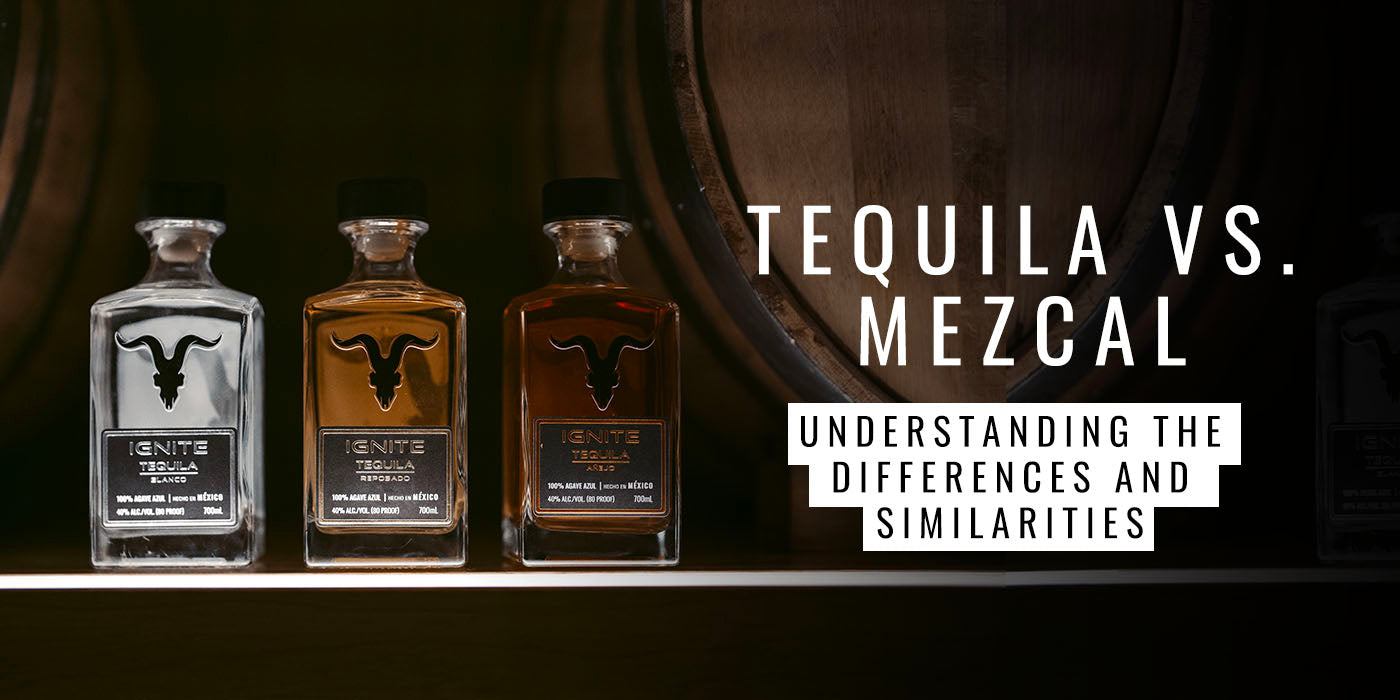Your Cart is Empty
Tequila vs. Mezcal: Understanding the Differences and Similarities
October 24, 2024 4 min read

Tequila has always been one of the most popular and widely used spirits. However, if you're craving something more smokey and velvety, you may consider exploring a flavorful mezcal.
If you're new to the world of tequila, you may be wondering what the difference is between tequila and mezcal. We're here to explore everything you need to know about mezcal vs. tequila so you can decide which spirit is best for you. Let's dive in.
Key Differences Between Mezcal and Tequila
All tequila is a type of mezcal. However, all tequila is made with Blue Weber agave. Blue Weber agave is typically sourced from plants found in Jalisco, Mexico. While mezcal can be made with any of the 30 types of agave. Mezcal also tends to be 5-10% stronger than most tequilas.
Flavor Profiles: What Distinguishes Mezcal from Tequila
Mezcal has a very smoky and earthy flavor profile. Roasting the agave plant helps bring out the smoky flavor of mezcal. Distilling the agave in clay stills gives mezcal a more earthy taste.
The flavor profiles of tequila can vary depending on how it's made. Most tequilas have a fresh, citrus, or peppery flavor. However, aged tequila can have a mild smokiness similar to mezcal.
How Mezcal and Tequila Are Made: Production Methods
After the agave is harvested, the agave is roasted in an underground oven for three to five days. Then, it is crushed before starting the fermentation process. After agave is fermented, it is moved to a clay or copper still for distillation. Most mezcal is distilled twice in small batches before being aged.
The production process for tequila is very similar. However, the production process is much quicker. After harvesting, the agave piñas are cooked in pressure cookers for less than two days before being crushed and fermented. Tequila is also distilled twice in larger copper stills. This gives it a more crisp, bright taste.

The Different Varieties of Tequila
Tequila varies depending on where and how it's made. These distinct differences can change the flavor profile and color. Some tequilas are better used as mixers, while others are enjoyed on the rocks.
The three most common types of tequila include:
Blanco
Blanco tequila is colorless and is not aged. Most blanco tequilas feature light and crisp flavors, like citrus and grass. This type of tequila is best used in margaritas, palomas, or a tequila sunrise.
Reposado
Reposado tequila is known for its yellowish, golden hue. Most are aged from two months to a year, depending on the brand. The aging process helps give the tequila a more distinct taste with flavors like hazelnut, chocolate, and tobacco. Reposado can be enjoyed neat but can also be great in spirit-forward cocktails.
Añejo
Añejo is an aged tequila with a deep amber color. Most Añejo tequilas are aged for a few years. The aging process gives this type of tequila a more full-bodied flavor palette. Most Añejo tequilas feature hints of dark chocolate, cinnamon, and tobacco. Tequila drinkers prefer to enjoy Añejo neat or over ice.
The Different Varieties of Mezcal
Just like tequila, mezcal can also vary. The taste and color of the mezcal will mainly depend on the type of agave used and how long it has aged.
The three most common types of mezcal include:
Joven
Most people compare the taste of Joven mezcal to Blanco tequila. This type of tequila still has the traditional smokey flavor, but it's commonly paired with citrus notes. Joven is also bottled immediately after distillation during the production process. Most individuals enjoy mixing joven mezcal with mixers like grapefruit juice or pineapple juice.
Reposado
Reposado mezcal gets the smoky flavor from the wooden vessels it's aged in after production. This type of mezcal has a smooth, velvety taste and typically features notes of caramel, vanilla, and toffee. Reposado mezcal is ideal for margaritas and old fashioneds.
Añejo
Añejo mezcal is typically aged for at least one year. This type of mezcal is known for its smokey and earthy flavor but sometimes also features notes of honey, banana, and oranges. Añejo mezcal can be enjoyed on its own or mixed with simple ingredients, like lime juice, ginger beer, or agave nectar.
Shop Quality Spirits With IGNITE
While the differences between mezcal and tequila are significant, both agave spirits are worth considering adding to your bar cart.
At IGNITE, our collection of award-winning spirits features a wide range of premium tequila. Whether you enjoy the full-body taste of Añejo or want something more crisp and classic like Blanco - we have a tequila that will satisfy your taste buds.
Find a store location near you.
FAQs:
What is the difference between mezcal and tequila?
The main differences between the two spirits are how it's made, what it's made with, and where it's made. Most tequilas are made with Weber blue agave in Jalisco, while mezcal can be made out of 400 different types of agave in various authorized states in Mexico.
Is mezcal a tequila?
Tequila is considered a type of mezcal. Mezcal is a general term that refers to any spirit made with the blue agave plant.
Is mezcal stronger than tequila?
Yes, most mezcals have a higher concentration of alcohol than most tequilas. You can expect most mezcals to be around 45-55% ABV and tequilas to be around 35%-45% ABV.
What flavor distinguishes mezcal from tequila?
Mezcal tends to have a smokier taste than most tequilas. This smokey taste is commonly paired with notes of leather, cinnamon, and chocolate.
Subscribe
Sign up to get the latest on sales, new releases and more …
